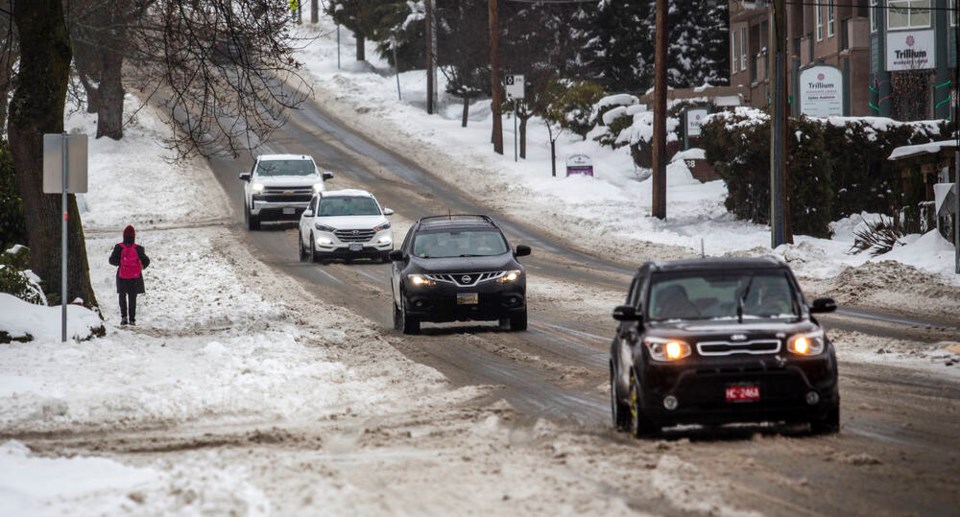We’ve been blessed with some unseasonably great weather in the past few weeks of the year. But the wet, slushy slippery stuff is sure to come and being able to steer through all that yuck is essential to driving safely in the winter.
I’m still watching lots of those crash videos on the internet because there’s never any shortage of material. One thing that keeps cropping up is situations where a driver avoids a catastrophic problem initially only to lose control of the vehicle afterwards and smash into a guard rail or plummet over the edge of the road.
Many of these disasters could have been avoided by knowing what to do when you start to skid.
Vehicles skid for a number of reasons, but the four main problems are: driving too fast for the road and weather conditions; turning much too sharply and at the wrong moment; accelerating too fast; and the main culprit, braking too hard.
On wet, slushy or snowy roads 10 km/h below the speed limit is a good idea. Braking or turns that in dry conditions are easy are lost when the weather turns. Your margin for error is essentially gone.
In any type of turn it’s best to slow down before you actually turn the steering wheel. This is even more important on slick streets. Slower, more deliberate and smooth actions are the best defence against a turning skid.
So you’ve done your best but you’re into a skid — what now? Well that depends on the type of skid.
In a front-wheel skid, your front wheels have lost traction. You turn the steering wheel but your vehicle is not responding i.e. going straight. It means that you have to get those front wheels back in the game. This is done by taking your foot off the gas and gently but firmly applying brake power.
This allows the front wheels to start turning again, which causes them to gain traction. It also creates a weight transfer from the rear to the front of the vehicle, also helping the front wheels to regain that traction.
In a rear-wheel skid, fishtailing occurs as the rear wheels break traction. You’re swerving from side to side as you try and correct. Now you need to transfer vehicle weight from the front of the vehicle to its rear.
Again, foot off the gas to allow vehicle weight to transfer from the front to the rear and then turn into your skid. In other words if you’re skidding off to the right, turn firmly but evenly to the right. If it’s a left skid, turn firmly but steadily to the left. Once you’ve gained control, slow and even acceleration can be used along with those same anti-skid turning manoeuvres to maintain your grip on the road.
In an understeering skid, you’ve entered into a curve that is much sharper than you first thought. Your initial turn is insufficient. It’s important here to resist the temptation to make a sharp correction by turning hard.
Again your best bet is to try and regain traction. Slow down firmly and evenly, then straighten out briefly. Slowly turn again with the direction of the road curve. Sharp reactions in this scenario will send you off the road.
One of the deadly phenomena of skids in curves happens when drivers smash directly into the object they most want to avoid, such as a tree or a power pole. This occurs because in moments of panic, the eyes focus the brain on that object of danger. Instead, look where you want to go — not where you might be headed. Steer into bushes, an open field or another part of the road.
Finally, we’ve all seen those classic moments when vehicle after vehicle slides down a slippery hill, totally out of control, into mayhem. You’re probably in a no-win skid scenario but your best defence here is to actually keep your wheels turning so that you at least have a chance at some steering control. Pressing harder and harder on the brakes is useless. Wheels that keep turning offer you at least a chance to steer out of danger.
All-wheel drive vehicles and anti-lock braking systems have solved many of our skidding concerns, but lousy conditions can still override technical safeguards. Slowing down in advance, getting off the gas and keeping your wheels turning are still the best ways to regain skid control.
Glove Box: As we reach the end of 2023 I’d like to hear from you about your best pet peeves on the road. Surveys like this are completely unscientific, but anecdotes can sometimes give us an interesting look into the good ideas or the problems we face as motorists. Look forward to hearing from you.



